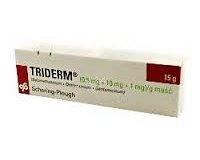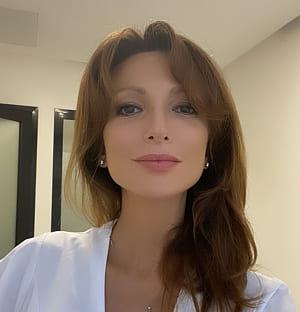

Triderm

Ask a doctor about a prescription for Triderm

How to use Triderm
Package Leaflet: Information for the Patient
Warning! Keep the leaflet, the information on the immediate packaging is in a foreign language.
Triderm, (0.64 mg + 10 mg + 1 mg)/g, ointment
Betamethasone dipropionate + Clotrimazole + Gentamicin
Read the leaflet carefully before using the medicine, as it contains important information for the patient.
- Keep this leaflet, so you can read it again if you need to.
- If you have any doubts, consult your doctor or pharmacist.
- This medicine has been prescribed specifically for you. Do not pass it on to others. The medicine may harm another person, even if their symptoms are the same as yours.
- If the patient experiences any side effects, including any side effects not listed in this leaflet, they should tell their doctor or pharmacist. See section 4.
Table of Contents of the Leaflet
- 1. What is Triderm and what is it used for
- 2. Important information before using Triderm
- 3. How to use Triderm
- 4. Possible side effects
- 5. How to store Triderm
- 6. Contents of the pack and other information
1. What is Triderm and what is it used for
The properties of Triderm result from the action of its active substances: betamethasone dipropionate, gentamicin, and clotrimazole.
Betamethasone dipropionate belongs to a group of corticosteroids with strong action, used locally it has a quick and long-lasting anti-inflammatory, anti-itching, and vasoconstrictive effect.
Gentamicin is an aminoglycoside antibiotic with antibacterial action.
Clotrimazole belongs to a group of imidazoles with antifungal action. It inhibits the growth of fungi that cause skin diseases. Clotrimazole acts on the fungal cell wall.
Indications
Triderm ointment is indicated for the symptomatic treatment of inflammatory skin changes that respond to corticosteroids, complicated by secondary infections caused by microorganisms, i.e., bacteria and fungi sensitive to gentamicin and clotrimazole.
The effectiveness of clotrimazole has been demonstrated in the local treatment of fungal infections of the groin, perineal area, feet, and non-hairy skin. Clotrimazole applied to the skin has an antifungal effect on Trichophyton rubrum, Trichophyton mentagrophytes, Epidermophyton floccosum, and Microsporum canis, candidiasis caused by Candida albicans, and pityriasis versicolor caused by Malassezia furfur(Pityrosporum orbiculare).
The bacteria sensitive to gentamicin include strains of streptococci (group A: β-hemolytic, α-hemolytic), Staphylococcus aureus(coagulase-positive, coagulase-negative, and some penicillinase-producing strains), and Gram-negative bacteria, such as Pseudomonas aeruginosa, Aerobacter aerogenes, Escherichia coli, Proteus vulgaris, and Klebsiella pneumoniae.
2. Important information before using Triderm
When not to use Triderm
- in viral skin infections (e.g., chickenpox, herpes);
- in rosacea;
- in acne vulgaris;
- in primary bacterial and fungal skin infections;
- on wounds, on damaged skin;
- on facial skin;
- in the anal and genital areas;
- in perioral dermatitis;
- for prolonged periods.
Warnings and precautions
Before starting to use Triderm, discuss it with your doctor or pharmacist.
If irritation, allergy, or infection occurs during treatment, discontinue use of Triderm and contact your doctor, who will provide appropriate treatment.
Prolonged use of the medicine may lead to the growth of gentamicin-resistant microorganisms and other aminoglycoside antibiotics.
Hypersensitivity to aminoglycoside antibiotics has been reported.
Triderm should not be used in the eyes or around the eyes and on mucous membranes.
The active substances of the medicine - betamethasone dipropionate and gentamicin - are absorbed through the skin into the body, and the intensity of their absorption increases under occlusive dressing (e.g., diaper).
During excessive and prolonged use of the medicine, there is a risk of systemic side effects characteristic of corticosteroids (including adrenal cortex suppression) and gentamicin (such as hearing loss, kidney damage, especially in people with kidney function disorders).
Therefore, it is recommended to avoid using the medicine on a large surface of the body, using it in large doses, and using dressings.
Patients with psoriasis should use the medicine with special caution, as using it in psoriasis can be dangerous, including the risk of disease recurrence due to the development of tolerance, the risk of generalized pustular psoriasis, and general toxic effects due to skin damage.
If the patient experiences blurred vision or other vision disturbances, they should contact their doctor.
Children
In children, more often than in adults, suppression of the hypothalamic-pituitary-adrenal axis occurs after local use of corticosteroids due to greater absorption of betamethasone dipropionate into the body than in adults.
In children who have used topical corticosteroids, the following have been reported: suppression of the hypothalamic-pituitary-adrenal axis, adrenal insufficiency, Cushing's syndrome (adrenal cortex hyperfunction), growth retardation, decreased weight gain, and increased intracranial pressure (e.g., bulging fontanelle, headaches).
Triderm and other medicines
Tell your doctor or pharmacist about all medicines you are currently taking or have recently taken, as well as any medicines you plan to take.
No interactions with other medicines are known.
Pregnancy and breastfeeding
If you are pregnant or breastfeeding, think you may be pregnant, or plan to have a child, consult your doctor or pharmacist before using this medicine.
There are no data on the safety of using the medicine in pregnant women.
The medicine may be used during pregnancy only if, in the doctor's opinion, the benefit to the mother outweighs the risk to the mother, fetus, or newborn.
Use of the medicine during pregnancy should be short-term and limited to a small skin surface.
The doctor will decide whether to stop breastfeeding or stop using the medicine, considering the benefit of treatment for the mother and the adverse effect on the child.
During breastfeeding, do not use the medicine on the breast skin.
Driving and using machines
There are no data on the effect of Triderm on the ability to drive and use machines.
3. How to use Triderm
Always use this medicine exactly as your doctor has told you. If you are not sure, consult your doctor or pharmacist.
This medicine is for use on the skin.
Apply a thin layer of Triderm to the affected areas and surrounding skin twice a day, in the morning and evening.
Use Triderm regularly.
Use in children
Do not use in children under 2 years of age.
In children over 2 years of age, use for no more than 5 days.
The duration of treatment depends on the size and location of the lesions and the patient's response to treatment. If no improvement occurs after 3-4 weeks, the doctor will verify the diagnosis.
Using more than the recommended dose of Triderm
If you have used more than the recommended dose of the medicine, contact your doctor or pharmacist immediately.
Excessive or prolonged use of the medicine may cause suppression of the hypothalamic-pituitary-adrenal axis, secondary adrenal insufficiency, and side effects characteristic of corticosteroids, including Cushing's syndrome, as well as the development of gentamicin-resistant bacterial strains and hearing and kidney damage.
Missing a dose of Triderm
Do not use a double dose to make up for a missed dose.
If you have any further doubts about using this medicine, consult your doctor or pharmacist.
4. Possible side effects
Like all medicines, Triderm can cause side effects, although not everybody gets them.
During treatment with Triderm, very rare (occurring in less than 1 in 10,000 patients) side effects have been observed; these include skin discoloration, anemia, burning sensation, redness, exudate, and itching of the skin.
Side effects may also occur that have been observed after local use of corticosteroids, clotrimazole, and gentamicin.
Due to the presence of betamethasone dipropionate in the medicine, burning sensation, itching, irritation, dryness of the skin, folliculitis, hypertrichosis, acne, skin discoloration, perioral dermatitis, allergic contact dermatitis, swelling or softening of the skin, secondary infections, skin atrophy, striae, and petechiae may occur.
As a result of the absorption of betamethasone dipropionate into the blood, general side effects of betamethasone dipropionate, characteristic of corticosteroids, may also occur.
These symptoms occur mainly in the case of prolonged use of the medicine, using it on a large skin surface, and using it in children.
Hypersensitivity reactions may occur. If hypersensitivity reactions occur, treatment should be discontinued immediately and a doctor consulted.
Due to the presence of clotrimazole in the medicine, redness, burning sensation, blistering, peeling, swelling, itching, urticaria, and general skin irritation may occur.
Due to the presence of gentamicin in the medicine, skin irritation (redness and itching) may occur, which usually does not require discontinuation of treatment.
During the use of corticosteroids, blurred vision (frequency not known - cannot be estimated from the available data) has been observed.
Reporting side effects
If you experience any side effects, including any side effects not listed in the leaflet, tell your doctor or pharmacist. Side effects can be reported directly to the Department of Drug Safety of the Office for Registration of Medicinal Products, Medical Devices, and Biocidal Products: Al. Jerozolimskie 181C, 02-222 Warsaw, Tel.: +48 22 49 21 301, Fax: +48 22 49 21 309, website: https://smz.ezdrowie.gov.pl.
Side effects can also be reported to the marketing authorization holder.
Reporting side effects will help to gather more information on the safety of the medicine.
5. How to store Triderm
Store below 25°C, in the original packaging.
Keep the medicine out of the sight and reach of children.
Do not use this medicine after the expiry date stated on the packaging. The expiry date refers to the last day of the month.
Medicines should not be disposed of via wastewater or household waste. Ask your pharmacist how to dispose of medicines no longer required. This will help protect the environment.
6. Contents of the pack and other information
What Triderm contains
- -The active substances of the medicine are: betamethasone dipropionate, clotrimazole, and gentamicin. Each gram of ointment contains 0.64 mg of betamethasone dipropionate (equivalent to 0.5 mg of betamethasone), 10 mg of clotrimazole, and 1 mg of gentamicin (as gentamicin sulfate).
- The other ingredients are: liquid paraffin, white petrolatum.
What Triderm looks like and contents of the pack
Triderm is an ointment.
Available packs:
Aluminum tube with a protective membrane, with a plastic screw cap with a piercer, in a cardboard box containing 15 g of ointment.
For more detailed information, please contact the marketing authorization holder or parallel importer.
Marketing authorization holder in Romania, the country of export:
ORGANON BIOSCIENCES S.R.L.
Strada Av. Popișteanu, Nr 54A, Expo Business Park, Clădirea 2
Birou 306 și Birou 307, Etaj 3, Sectorul 1, Bucharest, Romania
Manufacturer:
Organon Heist bv
Industriepark 30
2220 Heist-op-den-Berg
Belgium
Parallel importer:
Polypharm S.A.
ul. Barska 33
02-315 Warsaw
Repackaged by:
CEFEA Sp. z o.o. Sp. komandytowa
ul. Działkowa 56
02-234 Warsaw
Marketing authorization number in Romania, the country of export: 7214/2014/01
Parallel import authorization number: 275/24
Date of leaflet approval: 04.07.2024
[Information about the trademark]
- Country of registration
- Active substance
- Prescription requiredNo
- Marketing authorisation holder (MAH)ORGANON BIOSCIENCES S.R.L.
- This information is for reference only and does not constitute medical advice. Always consult a licensed doctor before taking any medication. Oladoctor is not responsible for medical decisions based on this content.
- Alternatives to TridermDosage form: Ointment, (0.5 mg + 1 mg)/gActive substance: betamethasone and antibioticsManufacturer: Przedsiębiorstwo Farmaceutyczne Jelfa S.A.Prescription requiredDosage form: Cream, 0.5 mg/gActive substance: betamethasone and antibioticsManufacturer: Belupo s.r.o.Prescription requiredDosage form: Ointment, 0.5 mg/gActive substance: betamethasone and antibioticsManufacturer: Belupo lijekovi i kozmetika d.d.Prescription required
Alternatives to Triderm in other countries
The best alternatives with the same active ingredient and therapeutic effect.
Alternative to Triderm in Ukraine
Alternative to Triderm in Spain
Online doctors for Triderm
Discuss dosage, side effects, interactions, contraindications, and prescription renewal for Triderm – subject to medical assessment and local rules.







